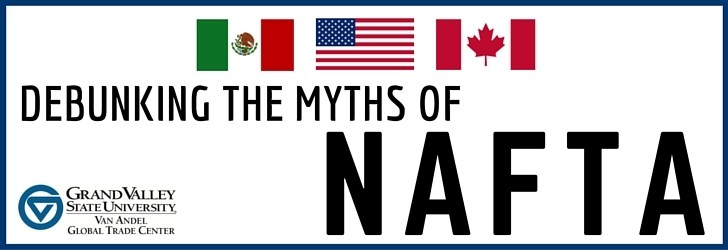In the News
Debunking the Myths of NAFTA
September 29, 2015

By Kellie Howe
U.S. Trade with Canada and Mexico supports over 140,000 small and medium-sized businesses. Often, many small business’ first foreign customers are in Canada and Mexico thanks to NAFTA.
Signed into effect in 1994, the North American Free Trade Agreement (NAFTA) created one of the world’s largest free trade zones. The agreement was built upon the prospect of growth, prosperity, and development for the economies of Canada, Mexico, and the United States. Included within the agreement, it has offered many safeguards and advantages to trading within North America.
However, despite being in effect for over 20 years, there are still many myths about NAFTA and its numerous regulations that keep businesses from taking advantage of all the benefits NAFTA has to offer. Programs such as Van Andel Global Trade Center’s Basics of NAFTA can help a business navigate the promising world of international trade.
Myth: The essential goals of NAFTA have not been achieved.
NAFTA was created to eliminate barriers to trade and investment between the U.S., Canada, and Mexico. When signed into effect, the agreement immediately eliminated tariffs on more than one-half of exports. Since 1994 when NAFTA took effect, the economy in all three participating countries has continually expanded. Today, the North American economy has a combined output upwards of $17.0 trillion USD. In addition, NAFTA has allowed for a standardized system as well as the paperwork to support importing and exporting easily within the three countries.
Myth: NAFTA has resulted in job loss/ hurt workers' labor standards and wages.
One in five jobs in Canada is in part linked to international trade. Between 1994 and 2008 the growth in jobs amongst NAFTA countries took a sharp increase with a combined 39.7 million new jobs, 25 million of which were in the United States alone. In addition, since NAFTA went into effect the North American Agreement on Labor Cooperation (NAALC) was implemented to ensure working and living standards were upheld, as well as enforce and enhance basic workers’ rights throughout North America.
Throughout the years, NAALC has raised public interest on labor rights issues such as protecting contracts, protection of migrant workers, and pregnancy-based discrimination. The NAALC has also promoted the enforcement of domestic labor laws throughout the countries of the NAFTA territory. In addition, NAFTA has promoted higher wages across all three countries. For example in Mexico, export firms employ one in five workers; these workers are paid on average 40% more than those in non-export jobs.
Myth: NAFTA does not advocate for the protection of the environment.
Much like the NAALC being put into effect for labor standards and wages, the North American Agreement on Environmental Cooperation (NAAEC) was put into place to uphold standards of protecting the environment. The NAAEC requires NAFTA countries to abide by certain regulations to improve and protect the environment. NAAEC, with a budget of $9 million USD annually, is responsible for:
- Development of North American management practices for toxic chemicals;
- Establishment of the first Mexican national air emissions inventory;
- Launch of the North American Bird Conservation Initiative, which provides a resource for bird conservation programs in the three countries;
- Promotion of best practices to address the linkages between the environment, the economy, and trade.
Myth: It is not easy to protect intellectual property when trading through NAFTA.
Part Six, Chapter 17 of the North American Free Trade Agreement, protects all intellectual property rights within the continent. Article 1701 clearly states, “Each Party shall provide in its territory to the nationals of another Party adequate and effective protection and enforcement of intellectual property rights, while ensuring that measures to enforce intellectual property rights do not themselves become barriers to legitimate trade.” For more information on intellectual property rights, refer to the mentioned section above of the North American Free Trade Agreement.
Myth: NAFTA has hurt the North American manufacturing base.
Contrary to popular belief, NAFTA has helped the North American manufacturing base by allowing easier access to raw material and finished products within the NAFTA borders. Also between the countries, NAFTA has allowed for better communication, sharing of technology and the talent of experts over its borders. After the implementation of NAFTA, both Canada and the U.S.’s manufacturing output rose by 62%.
Myth: The NAFTA paperwork and regulations are difficult to understand and keep up with.
With proper training, any business, small or large can begin working within NAFTA effectively and efficiently. To gain valuable information and start trading within NAFTA, attend Van Andel Global Trade Center’s Basics of NAFTA program in Grand Rapids on Friday, October 16, 2015 or in Ann Arbor on Wednesday, October 21, 2015 . This training will offer a clear understanding of the rules, regulations, and best practices for implementation of trade with the continent. Topics to be covered include:
- NAFTA Definitions & Responsibilities
- How to Fill Out a Certificate of Origin
- Qualifying Goods Using NAFTA Rules of Origin
- Tariff Shift
- Regional Value Content
- Country of Origin Marking Rules
- Supplier Solicitation Process
- NAFTA Compliance
For more information or to sign up for Basics of NAFTA, click here.
Sources:
Foreign Trade Information System: NAFTA - https://www.sice.oas.org/trade/nafta/chap-171.asp
NAFTA Now - https://www.naftanow.org/about/default_en.asp
US Department of Labor: NAALC - https://www.dol.gov/ilab/trade/agreements/naalc.htm
Commission for Environmental Cooperation: NAAEC - https://www.cec.org/Page.asp?PageID=1226&SiteNodeID=567
Office of the United States Trade Representatives - https://ustr.gov/sites/default/files/NAFTA-Myth-versus-Fact.pdf
US Chamber of Commerce - https://www.uschamber.com/above-the-fold/nafta-myths-and-realities
ABOUT THE CONTRIBUTOR
Kellie Howe is a senior at Grand Valley State University majoring in Public and Non-Profit Administration, with an emphasis on Budget and Finance with minors in Business and Writing. In the future, Kellie would like to attend law school and work in International Law. In her free time, she likes to spend time with family and friends outdoors, swim, waterski, and watch movies.

